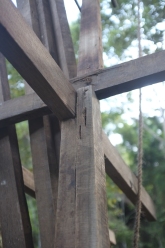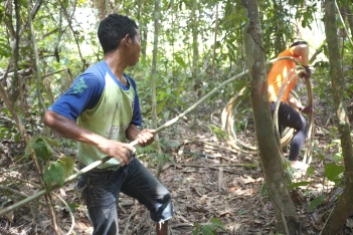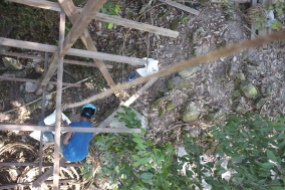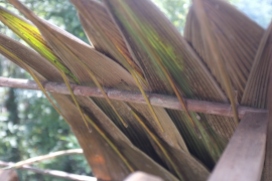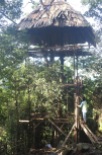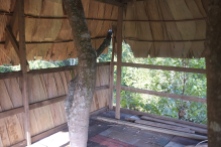A while back, I posted about my visit to a place in Johor Malaysia where treehouses sit in the canopy of the rainforest. A few months later, I went back to help Ah Yao (founder of Rainforest Treehouse), Salim and Wira, two Orang Asli (literally “original people” in Malay language), build another treehouse. The four photos below show from start (left) to almost finish (right).
1) Erecting the Frame

A 3-storey treehouse with the ground floor elevated.
The first thing to do is to pick a suitable site. The treehouse sits on trees and therefore we need strong and healthy trees to form the backbone of the building. The new treehouse would sit on two big trees running through the center with smaller supporting trees by the sides. The frame was made with long pillars and beams of tropic hardwood around 4 by 2 inches. Ah Yao bought them from a second-hand timber merchant. After that, they had to be manually carried up the hill into the forest two pieces at a time. I think I counted close to three hundred steps! Other than the weight of the dense timber on the shoulder, one has to maneuver the long pieces between the dense-growing trees. Rotation is impossible!
Setting up the frame would require a lot of climbing, which the Orang Asli are extremely adept at having grown up in the forest. There was a lot of tying, hammering, and sawing at height, often in very awkward positions. I was initially quite uncomfortable at such a height but slowly gained confidence. Mentally it was also challenging because it requires a lot of concentration and awareness of people and objects around you. I don’t speak Malay well but there was a mutual understanding that we’re looking out for one another as we work. There’s no safety gear and one man’s mistake can be a potential injury for another. Imagine someone accidentally dropping a hammer or a block of wood when another person is below him!
The treehouse would be sitting on a few living trees. There are many points of support to spread the weight. On every floor, a few of the beams would be secured to the trees. In addition, some of the weight is spread onto the forest floor through pillars for additional safety.
2) Foraging for Vines
Unlike the usual straight thatched roof, Ah Yao wanted to experiment with a round roof for this particular treehouse. For this purpose, we needed vines to create that circular shape to rest the attap leaves (palm leaves) on. The four of us, together with another volunteer Maggie, drove out to Kota Tinggi to forage for some thick vines.
After we brought back the many rolls of vines on Ah Yao’s truck, we had to manually carry them up the hill to the treehouse. From there, we unwound the rolls and used a rope to pull the vines up to the top floor. The vines had to go around the roof frame and nailed on it, which was a difficult task because we had no scaffolding.
3) Thatching the Roof
The attap leaves used for this roof are quite different from the other treehouse roofs here. What is commonly used in attap houses around Malaysia is the feathery leaf from the nipa palm (Nypa fruticans). While this special one is also a palm leaf, they are much bigger and of a single piece. Ah Yao bought them from the Orang Asli, who gather the leaves from the deep jungles.
4) Nailing the Floorboards
With the roof done, we can now work during rain and shine! We took a break from building to sort out the old boat wood that Ah Yao bought. They would be used for the floor decking. The wood pieces were sorted according to length, and some pieces that were too old and broken were thrown out. We then had to carry them up, three to four pieces at a time on the shoulder. This was probably the most physically demanding task because we needed many pieces for three stories. The boat wood was really solid and dense as well!
After that it was a lot of hammering and sawing. Being a newbie, I hammered my thumb and sawed my hands a good few times…
5) Putting on Walls
Finally, we got to the walls after finishing the floors. We took some time designing the walls because there were many considerations. We wanted ventilation, good views, privacy, safety, and protection from heavy rain and winds. As you can imagine, some of these demands are contradictory to others. How do you get ventilation and good view with a wall constructed for privacy and shelter!
The view on the top floor was amazing and we decided to keep it as open as possible. The wall facing the walkway would be thatched to waist level for privacy. The other three sides would be barricaded for safety without blocking much view.
For the bottom floor, we tried a vertical louvre wall to give the guest the option of opening up for ventilation and view, or closing up (partially or fully) for privacy. It was made using second-hand pine wood. Pinewood is much softer and lighter compared to tropical hardwood. It also does not last long in the tropical heat and humidity. However, since the wall does not bear weight and does not get much rain, pinewood would suffice.
It took us four weeks to get to this stage and unfortunately I had to leave. Other than the newly acquired natural building skills, it was quite an experience spending time with the two Orang Asli. While they are shy with humans, they seem very comfortable and relaxed in the forest. Even as we work, they have an incredible interest and awareness with what’s going on around the forest. Often times in the middle of work, they would mimic the sounds of chirping birds. They would look up suddenly and a squirrel would be nearby, even though I had no clue. After a tiring day of work, they would still run into the forest when they hear monkeys nearby. They seem to be one with the forest.

Salim playing with his new smartphone
Interestingly, they also got their first smartphones in the middle of my stay. I guess it was so addictive that they couldn’t stop playing with it throughout the day during breaks. Hopefully I’ll be back soon to see how they cope with it!


















